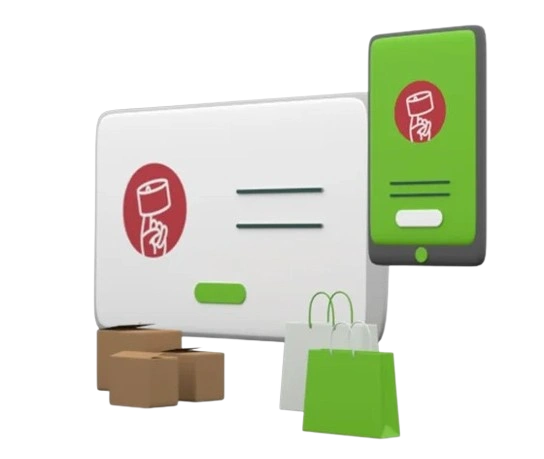How to Choose the Right Software for Multi-Channel Ecommerce Order Management

Selling across Amazon, Flipkart, your Shopify store, Instagram, and even brick-and-mortar outlets presents a compelling growth opportunity. It offers maximum visibility, diversified revenue streams, and broader reach. But in practice? Multi-channel selling often turns into a logistical nightmare.
When each sales channel functions in isolation, businesses lose visibility over critical order, inventory, and fulfillment data. One customer might check out the last available item online, while a store associate simultaneously sells the same SKU at the POS. The result? Inventory discrepancies, shipment delays, and a breakdown in customer confidence.
Without a centralized system, managing these disparate touchpoints becomes increasingly difficult. And in a world where customer expectations are sky-high and reviews travel faster than inventory, poor experiences can permanently damage your brand.
In this blog, we delve into how the right Order Management System (OMS) can simplify operations, eliminate fulfillment inefficiencies, and help your business navigate multi-channel e-commerce.
The Hidden Costs of Manual Multi-Channel Management
It’s easy to assume that managing your orders manually or with basic tools like spreadsheets can save money. But in reality, the hidden costs of this patchwork approach add up fast:
- Time Drain: Your teams spend countless hours reconciling orders, cross-checking stock levels, or resolving discrepancies between platforms. Last year, businesses using manual systems spent up to 30% more time on these tasks compared to those with automated solutions.
- Operational Errors: Overselling, duplicate shipments, missed deliveries—manual processes increase the chance of human error significantly. A report this year found that stockouts and overselling occurred 2.5x more often in businesses without integrated order management.
- Resource Misalignment: Instead of focusing on growth, your staff is stuck in firefighting mode. In a 2024 survey, over 40% of e-commerce teams cited manual order handling as the top barrier to strategic initiatives.
- Stalled Scaling: If your tech infrastructure can’t keep up with rising demand, scaling to new markets or channels becomes impossible.

Simplify multi-channel sales with Ginesys’ centralized OMS dashboard.
What Great Multi-Channel OMS Software Looks Like
A capable Order Management System (OMS) should do more than just track orders—it should function as the operational backbone of your commerce strategy, centralizing workflows and delivering complete visibility across every sales touchpoint.
As your business grows, so does the complexity of managing orders, inventory, and fulfillment. A powerful OMS turns that complexity into clarity, offering a single source of truth for all transactions, inventory movements, and fulfillment actions.
It should include key capabilities such as:
- Centralized dashboard to view and manage all incoming orders from various channels in one unified interface.
- Real-Time inventory sync to automatically update inventory levels across all platforms, preventing overselling.
- Automated fulfilment to trigger packing, shipping, and invoicing actions with minimal manual intervention.
- Seamless integrations that let you connect with ERP, accounting software, shipping partners, CRMs, and POS systems.
According to Brightpearl, a great OMS serves as the "command center" for your business—an intelligent, integrative middle layer that connects the dots between your front-end channels and back-end operations. It ensures that every stakeholder, from warehouse staff to customer support teams, is working with the same up-to-date information
Inventory Harmony: The Core of Effective Order Fulfillment
At the heart of order management is inventory control. Disconnected systems mean inventory becomes a moving target—especially when dealing with returns, exchanges, or high-velocity sales periods.
A robust OMS brings order to this chaos by providing real-time synchronization and centralized oversight, allowing businesses to maintain inventory accuracy at scale.
- Real-Time Inventory Visibility: Gain a live view of stock levels across warehouses, stores, and digital storefronts. This ensures that e-commerce channels always have accurate data on what's available, where it's located, and how fast it can be dispatched.
- Automated Adjustments: The system automatically updates inventory based on customer interactions such as returns, cancellations, or order modifications. These updates happen instantly, reducing manual errors and ensuring inventory records remain current at all times.
- Centralized Catalog Control: Manage your entire product catalog—including SKUs, pricing, descriptions, and variants—from one interface. This consistency is crucial for maintaining brand integrity and operational efficiency across marketplaces, D2C websites, and physical stores.
When inventory is intelligently managed through a centralized OMS, fulfillment becomes smoother, and the risk of overselling plummets.

Automate inventory sync across channels using Ginesys’ intelligent order management platform.
Speed, Accuracy, Satisfaction: Order Processing That Delivers
Order processing speed is a key competitive differentiator, particularly in the age of one-day delivery. Moreover, fast, reliable fulfillment has become synonymous with brand trust and marketplace success.
This is where a smart OMS adds value—by optimizing order flow from placement to delivery with minimal human intervention.
- Smart Order Routing: Orders are automatically assigned to the optimal fulfillment location—be it a warehouse, dark store, or physical outlet—based on inventory levels, customer proximity, and delivery timelines.
- Batch Processing: The system allows for the processing of large volumes of orders simultaneously, which significantly cuts down on manual and repetitive tasks. This is especially critical during peak sales periods, promotional campaigns, or flash sales when order spikes can overwhelm manual processes.
- Courier Auto-Assignment and Tracking: Integrated shipping logic automatically selects the best courier based on destination, cost, and service level, then triggers real-time tracking updates.
Beyond Marketplaces: Managing D2C, Retail, and Omnichannel Together
Modern brands juggle multiple revenue models—ranging from brand-owned D2C websites and brick-and-mortar retail stores to subscription-based offerings and large-scale reseller networks. The complexity of fulfilling and tracking orders across all these avenues makes a strong omnichannel order management system essential.
A purpose-built OMS is a strategic asset that brings structure and clarity to a fragmented retail ecosystem. With the right OMS, businesses can:
- Unify All Sales Streams: Centralize orders from marketplaces, physical stores, brand websites, and wholesale accounts into one system. This eliminates duplication, enables better inventory allocation, and ensures no channel is working in isolation.
- Enable Advanced Features: Power up your customer experience by supporting modern retail capabilities such as in-store pickups for online orders, cross-channel returns and exchanges, drop shipping from partners, and endless aisle inventory extension.
- Create Consistent Experiences: Whether a customer clicks “buy now” from an Instagram ad or walks into your flagship store, the interaction should be seamless and uniform.

Save Time and Avoid Errors with Automation
Rule-based automation is a strategic enabler for operational efficiency and business scalability. In multi-channel environments, where order volumes fluctuate and fulfillment timelines are tight, automation allows businesses to operate with agility, speed, and precision. In fact, businesses that have implemented automated order management systems have reported up to 45% fewer order errors and 60% faster order processing times.
By embedding intelligence into your order workflows, you shift from reactive operations to proactive execution. The right system will allow you to:
- Auto-Route Orders: Dynamically assign orders to the most optimal warehouse or fulfillment center based on geographic location, delivery SLAs, inventory availability, or customer segment priority.
- Auto-Generate Documents: Automatically create and distribute critical paperwork like invoices, shipping labels, packing slips, and customer confirmations.
- Trigger Stock Transfers or Alerts: When inventory hits predefined thresholds, the OMS can automatically initiate internal stock transfers, reorder suggestions, or send alerts to relevant teams.
Real-Time Visibility: Tracking Orders from Click to Delivery
Transparency is a core customer expectation today. Customers want to know where their orders are, and internal teams need visibility to manage operations proactively. This is possible with top OMS solutions that offer:
- End-to-End Order Tracking: Full traceability from order confirmation to picking, packaging, shipping, and final delivery—across all sales channels. This visibility empowers both customer-facing and backend teams to monitor progress and act swiftly when issues arise.
- Customer Self-Service: Proactive updates via SMS, email, or push notifications that include real-time tracking links. These not only enhance customer experience but also reduce the volume of inbound support requests.
- Internal Dashboards: Role-based dashboards allow warehouse teams, customer service reps, and logistics managers to identify delays, bottlenecks, or unusual order patterns. This enables faster resolution and improves interdepartmental coordination.

Integrate POS, online, and marketplace orders into one platform with Ginesys’ unified retail software.
Scalability That Matches Your Growth Ambitions
Startups and SMBs often outpace their initial tech stacks faster than anticipated. As demand surges, new channels emerge, and operations expand, many businesses find that their current systems simply can’t keep up.
What to look for in an OMS to support growth:
- High Data Load Capacity: Your OMS should process thousands of concurrent orders, updates, and API calls without downtime or degradation in performance.
- Modular Flexibility: Whether you're onboarding new warehouses, opening pop-up retail stores, or integrating with additional marketplaces, the system should allow seamless scaling—without disrupting existing workflows or requiring a full tech overhaul.
- Support for Emerging Models: From D2C subscriptions and marketplace aggregators to dark stores and quick commerce, your OMS should adapt as your business model evolves and new sales formats emerge.
How Ginesys Simplifies Multi-Channel Order Management
Ginesys OMS, an enterprise-grade order management system, is purpose-built to help retail businesses unify and automate their multi-channel operations—from eCommerce to ERP and POS systems—under one powerful platform. It enables seamless order syncing, real-time inventory visibility, and intelligent fulfillment across all sales channels.
Key features include:
- Omnichannel Syncing: Orders from online marketplaces (Amazon, Flipkart, Myntra, etc.), shopping carts (Shopify, WooCommerce, Magento), and offline stores are captured and processed through a single system. Inventory is updated in real time from across your ERP, POS, warehouses, to webstores and marketplaces.
- Automated, AI-Driven Workflows: From order routing and reservation to invoicing, picking, packing, and shipping—Ginesys OMS automates the full order lifecycle. Smart order allocation based on warehouse stock, location, or delivery SLA reduces manual effort and improves fulfillment speed.
- Deep ERP Integration: Natively integrated with its ERP and compatible with SAP, Microsoft Dynamics, Oracle, and others, Ginesys ensures end-to-end data flow for inventory, orders, accounting, and analytics—eliminating silos and manual reconciliation.
- Smart Connectivity Across the Ecosystem: With 100+ pre-built integrations for marketplaces, logistics providers (Delhivery, Shiprocket, Blue Dart), payment gateways, and accounting platforms, Ginesys OMS fits smoothly into any tech stack and accelerates go-live.
- Flexible, Scalable, Secure: Designed for high-growth brands, Ginesys OMS supports multi-store, multi-location, and multi-channel fulfillment strategies like Click & Collect, Ship from Store, and Endless Aisle. It features advanced analytics, barcode-based scan & pack, and 2048-bit data encryption for performance and compliance at scale.

Cut errors and speed up processing with Ginesys’ automated multi-channel order routing solutions.
Managing multi-channel ecommerce doesn’t have to feel like chaos. With the right Order Management System (OMS), you can centralize operations, automate routine workflows, and unlock real-time insights—turning complexity into control. As ecommerce expands across platforms and expectations rise, a robust OMS becomes your strategic advantage.
Retailers using Ginesys benefit from faster turnaround times, reduced stockouts, accurate order processing, and centralized control—empowering them to grow profitably across every channel.
Ready to take control of your order flow? Schedule a demo with Ginesys and discover how its multi-channel OMS can bring clarity, efficiency, and confidence to your ecommerce operations.
